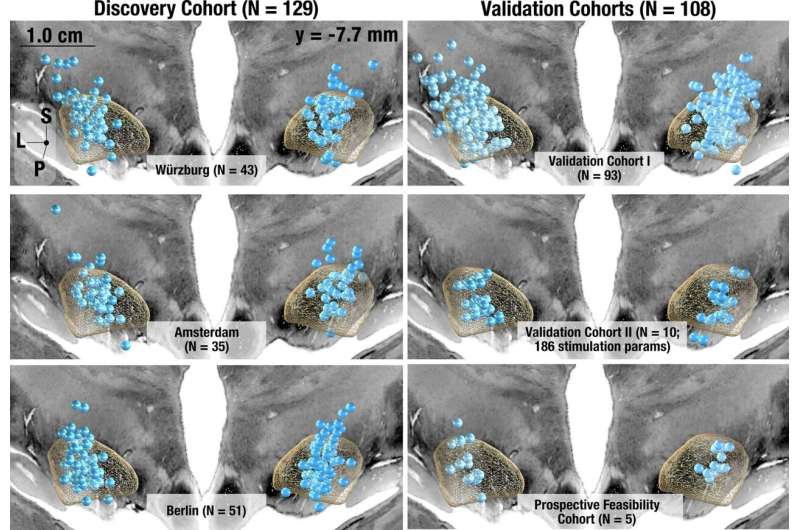This article has been reviewed according to Science X's editorial process and policies. Editors have highlighted the following attributes while ensuring the content's credibility:
fact-checked
peer-reviewed publication
trusted source
proofread
New deep brain stimulation algorithm may help personalize Parkinson's disease treatment

Deep brain stimulation (DBS) has shown promise as a treatment for some symptoms of Parkinson's disease (PD). However, not all symptoms improve equally well with DBS. A better understanding of how different sites of electrical stimulation impact the wide range of motor symptoms associated with PD could help fine tune treatment.
By studying PD patients at five different centers treated with DBS, investigators from Mass General Brigham have created an "atlas" that mapped four major symptoms of PD onto different regions of the brain. Based on these findings, the team created an algorithm capable of generating personalized, symptom-specific DBS treatment plans, which they preliminarily tested in five patients. Findings, published in Nature Communications, demonstrate the algorithm's potential to improve patients' symptoms beyond standard-of-care approaches.
"There is already strong evidence of improved quality of life for PD patients treated with DBS, but currently we still use a 'one-size-fits-all' approach to treatment," said senior author Andreas Horn, MD, Ph.D., a Mass General Brigham neurologist who holds titles at the Center for Brain Circuit Therapeutics in the Department of Neurology at Brigham and Women's Hospital and the Center for Neurotechnology and Neurorecovery at Massachusetts General Hospital. "The techniques we have developed will help us readily tailor DBS to what each patient specifically needs and improve DBS even further."
The researchers from Mass General Brigham studied a total of 237 patients with PD who were treated with DBS to identify tracts associated with four major PD symptoms: tremor (uncontrolled movement), bradykinesia (slow movement), rigidity (freezing), and axial symptoms (such as gait and posture irregularity or instability).
With software developed by Horn's team, the researchers pinpointed the precise location of DBS electrodes in each patient and created a common map of the circuits associated with patients' symptom improvement. Tremor was shown to improve with stimulation of tracts connected to the primary motor cortex and cerebellum, while bradykinesia was associated with the supplementary motor cortex. Rigidity was shown to improve with stimulation of the premotor cortex.
Axial symptoms, which have not received extensive study in relation to DBS, improved with stimulation of tracts connected to the supplementary motor cortex and brainstem. This finding may be especially important given that axial symptoms, such as gait or postural stability problems, typically do not respond well to DBS and existing dopaminergic therapies, such as levodopa.
Based on their findings, the investigators created Cleartune, an algorithm that suggests optimal stimulation parameters for DBS stimulation. The researchers applied Cleartune to inform treatment for five PD patients in Germany undergoing DBS. In four of the five patients, Cleartune settings led to greater improvements in PD symptoms than standard-of-care protocols. The fifth patient showed comparable improvements with Cleartune versus standard treatments.
The researchers are continuing to refine personalized, symptom-specific treatment for PD and other diseases such as OCD, in partnership with Mass General Brigham researchers, who plan to map the brain's circuitry more completely using advanced imaging technologies.
"This was an interdisciplinary effort to create the most precise atlas of symptom-specific pathways that we could," said first and corresponding author Nanditha Rajamani, Ph.D., of Mass General Brigham. "We went a long way to use anatomical information from many different sources and worked with highly skilled neuroanatomists to produce and validate this research. Going forward, this approach can be a framework for improving DBS treatments for other disorders as well."
More information: Nanditha Rajamani et al, Deep brain stimulation of symptom-specific networks in Parkinson's disease, Nature Communications (2024). DOI: 10.1038/s41467-024-48731-1



















